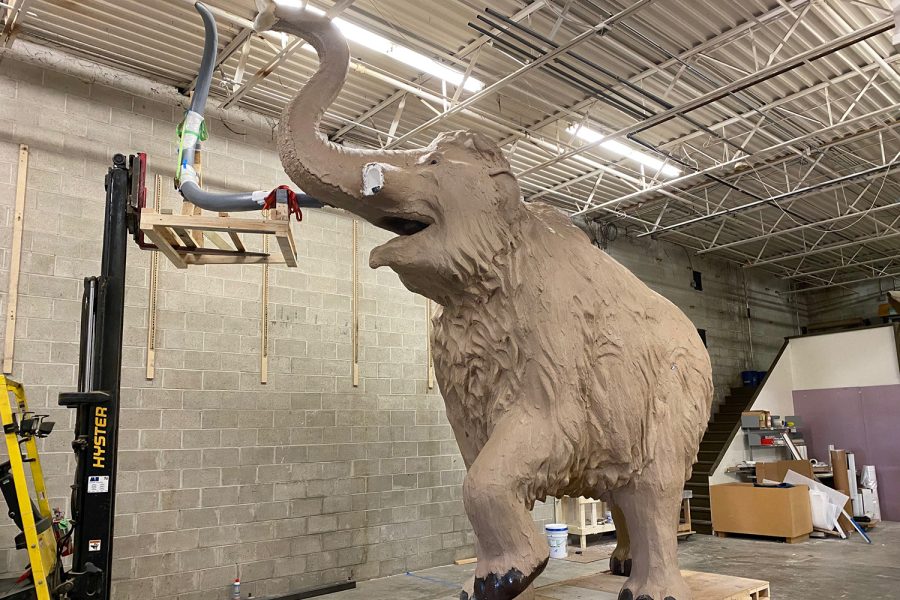New mammoth sculpture to stomp onto campus
Photo courtesy of Stephen Marshak
The mammoth statue, which is currently unfinished, will soon make its way to its final home on the south side of the Natural History Building.
March 14, 2023
Some 30,000 years and an extinction after the ancestors of modern-day elephants may have stomped through prehistoric Champaign-Urbana, a new mammoth is poised to set foot on campus.
On Monday, an approximately 12-foot-high and 15-foot-long statue of a mammoth is slated to be erected at the southwest corner of the Natural History Building. Currently, a bare wooden plank with the words “UofI Mammoth” marks the lone mammoth’s future home.
It will “display one of the most dramatic mammals ever to live in Illinois,” said Stephen Marshak, a professor emeritus in LAS and a director emeritus at the School of Earth, Society, & Environment. Marshak is one of the people behind the Mammoth project.
The proposal to erect a mammoth sculpture came from a committee set up by Facilities & Services in 2015, which included Marshak, administrators from the schools who use the Natural History Building, representatives from Facilities & Services and a professor in FAA. According to Marshak, the idea was first proposed by Marshak and Fred Delcomyn, the then-director of the School of Integrative Biology.
Funds to pay for the project came from the state’s “Art-In-Architecture” program, which requires that a percentage of the budget from major construction projects on campus go towards the purchase of art. The Mammoth’s funding stemmed from the renovation of the Natural History Building in 2014.
Get The Daily Illini in your inbox!
“We suggested the mammoth because it reflected the heritage of the Natural History Building, which has always been a home for geology and biology, and for many years hosted a Museum of Natural History, which contained casts of mammoth skeletons,” Marshak said. “It also reflects an intersection of earth sciences and life sciences.”
The project would stall for a few years before an updated committee including Marshak, Delcomyn and the current directors of SESE and SIB pushed the project forward.
Marshak also credited Facilities & Services planner Erika Lee, whom he said “inherited” the mammoth project and expertly navigated the “logistical details necessary to make the sculpture a reality.” Lee could not be immediately reached for comment.
Taylor studios, a museum exhibit construction company based in Rantoul, Illinois and one of the “foremost in the world” according to Marshak, was commissioned to build the mammoth.
“The decision was made to obtain a realistic mammoth sculpture – one that the public could instantly identify and could provide a learning experience – rather than an abstract sculpture,” Marshak said.
“We presented numerous photos to the artists at Taylor Studios to come up with the final design,” Marshak said. “And we consulted with paleontologists to catch errors.”
Taylor Studios produced a 3D computer model of the mammoth, and after it was approved, they made a scale model using 3D printing. “From that, the full-scale sculpture was made,” Marshak added.
The sculpture has a steel skeleton underneath a layer of styrofoam, which is then coated by fiberglass. This is then coated with epoxy, a type of resin, which is “shaped to provide the details before being painted,” according to Marshak.
The tusks of the Mammoth, however, came from a mold made from actual fossilized mammoth tusks.
Marshak lauded the artists for using their skills to “produce a sculpture that looks realistic and dramatic at the same time,” as well as using techniques that make sure the Mammoth will be durable enough to survive the harsh weather conditions of its one-time homeland.
After installation, the area around the Mammoth will be designed to become what Marshak called a “Pleistocene garden,” with “plantings that are related to those that would have been in the area of Champaign-Urbana when mammoths first arrived here (around 30,000 years ago).”
An informational display with an explanation for the scene and information about mammoths and the Ice Age will also be erected.
“We hope the mammoth will be eye-catching to the University community as well as to the public in C-U and to people visiting the campus,” Marshak said.
Paleontological evidence, according to Marshak, suggests that nammoths went extinct in present-day Illinois about 13,000 years ago.
“A real mammoth could very well have once stood on the spot where the sculpture will stand,” Marshak said.







